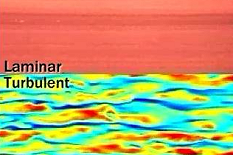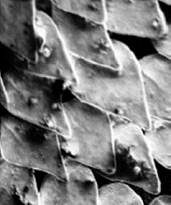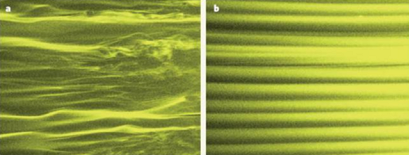![]() Laminar to Turbulent Flow Transition Control using Lyapunov’s Direct Method
Laminar to Turbulent Flow Transition Control using Lyapunov’s Direct Method
Executive Summary
 |
|
Example of the different fluid element patterns in laminar and turbulent flows [Introduction to Fluids Instructional Video] |
Laminar flow control research area targets regions of fluid dominated by viscous effects (boundary layers). Boundary layer exists either in a laminar or turbulent state. Skin friction drag when the boundary layer is turbulent is almost 90% higher than when the boundary layer is laminar. To reduce energy consumption it is, therefore, desirable, at least in cruise conditions, to have a laminar boundary layer. The difficulty of this problem lies in the fact that laminar flow in its natural state is very unstable and it is easily upset by external disturbances. It is the objective of the laminar flow control research to develop a technology that would actively and efficiently damp out these disturbances, preventing the transition from laminar to turbulent flows.
Primary Objectives
Disturbances that exist in the freestream (i.e. noise) perturb and couple with impurities in the boundary layer caused by, for example, roughness elements or surface waviness establishing the initial conditions for the breakdown of laminar flow. This governing mechanism causing transition could be therefore manipulated by intelligently introducing small changes to the aerodynamic surface texture (i.e. intelligently orientated wavy surface with specific wavelength and amplitude). This project is mainly based on a biomimetic principle. Namely, sharks are known as fast and efficient swimmers due to the specifics of their skin roughness design. The ultimate focus of this research is a development of an adaptive, simple, low weight and low power system based on this attractive and beneficial design existing in the nature. The goal is a more realizable and more efficient approach in achieving overall vehicle drag reduction.
 |
 |
| Shark skin details and the goal of applying the flexible and energy efficient skin to the aviation industry [King A., Call G., “Shark Skin”, University of Reading] | |
Research Description
The approach taken in this project is based on Lyapunov’s Direct Methods. Energy based distributed parameter feedback control system and a distributed parameter self sensing smart material actuator that will actively extract energy from the boundary layer disturbances and delay transition from laminar to turbulent flow will be explored. A control law of similar nature was successfully used to design an active vibration damper for structures. The resemblance between fluid flows and structures in that they are both systems distributed in nature initiated this study to investigate the benefits of designing adaptive, time dependent surface patterns on aircraft surfaces to dynamically influence or damp the development of particular flow features in the boundary layer in order to delay transition from laminar to turbulent flows. The main issues include (i) the selection of the energy related function which contains the closed loop system states and (ii) the design of the actuator distribution that would cause the time variation of the energy functional to decrease implying that the energy is being dissipated or held a constant level. Ultimately, this approach requires less energy and the system may employ a single, spatially distributed actuator in a form of a sheet of a patterned PVDF film, designed according to the control law technique formulated.
Figures below show some existing examples of laminar flow control techniques that demonstrate the influence of the surface texture on the stability of the flow. It is intriguing that an intelligently designed rough surface (right) can have less skin friction drag than the most polished surface shown on the left.

Example of an intelligently designed rough surfaces (right) having less skin
friction than the most highly polished surfaces (left)
[Choi K., “The Rough with the Smooth”, Nature, Vol 440, April 2006]
![]()

